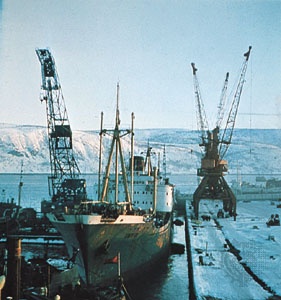Murmansk
Russia
formerly (until 1917) Romanov-na-murmane
 seaport and centre of Murmansk oblast (region), northwestern Russia, lying 125 mi (200 km) north of the Arctic Circle, and on the eastern shore of Kola Bay, 30 mi from the ice-free Barents Sea. The town, founded in 1915 as a supply port in World War I, was a base for the British, French, and American expeditionary forces against the Bolsheviks in 1918. In World War II Murmansk served as the main port for Anglo-American convoys carrying war supplies to the U.S.S.R. through the Arctic Ocean. The town is now an important fishing port, and its fish-processing plant is one of the largest in Europe. Murmansk's ice-free harbour makes it Russia's only port with unrestricted access to the Atlantic and world sea routes. From December to May it replaces icebound St. Petersburg as the major port of the northwest. Murmansk is connected by railroad with St. Petersburg and Moscow and the mining and industrial centres of Monchegorsk and Kirovsk. Major industries in Murmansk include fishing, fish processing, and shipbuilding. Education and research establishments include a teacher-training institute and a research institute of marine fisheries and oceanography. Following the collapse of the Soviet Union in 1991, Murmansk's economy suffered, as major industries were unprofitable under market economy conditions and most fishing vessels were contracted out to Norwegian and other foreign companies. As a result, many people left the city, and in the 1990s the city's population dropped by more than one-fourth, though by the early 21st century the city had made a successful transition to a market economy. Murmansk is the largest city in the world north of the Arctic Circle. Its name probably derives from the local Sami word murman, meaning “the edge of the earth.” Pop. (2005 est.) 325,101.
seaport and centre of Murmansk oblast (region), northwestern Russia, lying 125 mi (200 km) north of the Arctic Circle, and on the eastern shore of Kola Bay, 30 mi from the ice-free Barents Sea. The town, founded in 1915 as a supply port in World War I, was a base for the British, French, and American expeditionary forces against the Bolsheviks in 1918. In World War II Murmansk served as the main port for Anglo-American convoys carrying war supplies to the U.S.S.R. through the Arctic Ocean. The town is now an important fishing port, and its fish-processing plant is one of the largest in Europe. Murmansk's ice-free harbour makes it Russia's only port with unrestricted access to the Atlantic and world sea routes. From December to May it replaces icebound St. Petersburg as the major port of the northwest. Murmansk is connected by railroad with St. Petersburg and Moscow and the mining and industrial centres of Monchegorsk and Kirovsk. Major industries in Murmansk include fishing, fish processing, and shipbuilding. Education and research establishments include a teacher-training institute and a research institute of marine fisheries and oceanography. Following the collapse of the Soviet Union in 1991, Murmansk's economy suffered, as major industries were unprofitable under market economy conditions and most fishing vessels were contracted out to Norwegian and other foreign companies. As a result, many people left the city, and in the 1990s the city's population dropped by more than one-fourth, though by the early 21st century the city had made a successful transition to a market economy. Murmansk is the largest city in the world north of the Arctic Circle. Its name probably derives from the local Sami word murman, meaning “the edge of the earth.” Pop. (2005 est.) 325,101.oblast, Russia
oblast (region), northwestern Russia, occupying the Kola Peninsula between the White and Barents seas. Its upland blocks and mountain massifs, rising to 3,907 feet (1,191 metres) in the Khibiny Mountains, are covered by tundra in the north and swampy forest, or taiga, in the south. The economy is dominated by mineral exploitation, principally apatite, nepheline, iron, and nickel; fishing is important along the coasts. Its administrative centre is Murmansk. Area 55,950 square miles (144,900 square km). Pop. (2006 est.) 864,607.
- Kálnoky von Köröspatak, Gusztav Siegmund, Graf (count)
- Kálvos, Andréas Ioannídis
- Kármán, Theodore von
- Károly Eötvös
- Károly Flesch
- Károlyi, Mihály, Count
- Károly Kerényi
- Károly Kisfaludy
- Károly Takács
- Kárpathos
- Kâmil Paşa, Mehmed
- Kâmpóng Cham
- Kâmpóng Chhnăng
- Kâmpóng Saôm
- Kâmpóng Spoe
- Kâmpóng Spœ
- Kâmpóng Thum
- Kâmpôt
- Kâtip Çelebi
- Kämpfer, Engelbert
- Kändler, Johann Joachim
- Kärnten
- Käsebier, Gertrude
- Kästner, Erich
- Käthe Kollwitz